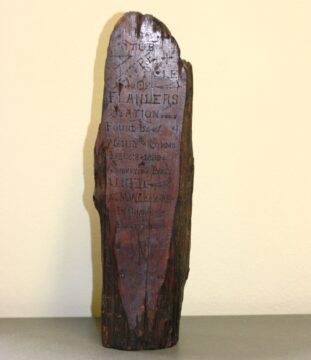
During the month of August, Rosenberg Library exhibited a cedar post used in the first U.S. Coastal Survey of Galveston Bay in 1850. This artifact was found at Flanders Station and was donated to the Library by S.M. Wilcox in 1925.
Flanders Station
Flanders Station (also known as Flanders Grove or Flanders Labor) was named for John Flanders, a New England farmer who settled in Austin’s Colony in 1830. Within a few years, he acquired property near the mouth of Clear Creek where it enters Galveston Bay. Shortly after joining the Texas Army in the war for independence from Mexico, Flanders was killed. He is listed among those who died at the Alamo in 1836.
In 1850, the United States government oversaw the first coastal survey of the Galveston Bay region. During that era, surveyors placed cedar posts at each quarter-mile to serve as temporary survey markers. In 1899, during a subsequent survey, team members were surprised to find the remains of an 1850 post in what was formerly Flanders Station. Today the site is part of the City of Kemah.
S.M. Wilcox
The survey post was collected and preserved by Samuel Morey Wilcox, an Assistant Engineer for the United States Engineering Department in charge of the Galveston region. He retired in 1934 after 46 years of service. Wilcox died in 1940, and in 1942, the U.S. Engineers named a tugboat in his honor.
©2025 Rosenberg Library Museum
